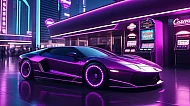This post was published by a guest. The views expressed are those of the author and do not necessarily reflect the views of Scified.com.
In the diverse world of academic writing, the alignment of style with subject matter can profoundly impact the efficacy of communication. This concept mirrors the realm of science fiction, where different genres cater specifically to unique themes and target audiences. Just as a cyberpunk novel wouldn’t approach its narrative in the same way as a space opera, an academic paper in sociology would differ markedly in style from one in engineering.
The style of an academic paper is not just a superficial layer; it fundamentally shapes how the information is perceived and understood. A well-chosen style enhances readability, boosts engagement, and ensures the comprehension of complex ideas. Effective academic writing, therefore, involves more than just thorough research and robust arguments; it requires a style that complements the content, engaging the reader and clarifying the nuances of the discipline.
Understanding Writing Styles in Different Academic Disciplines
Academic disciplines are broadly categorized into sciences, humanities, and social sciences, each favoring a distinct writing style. Scientific writing, for example, prioritizes precision and objectivity, often using passive voice and complex terminology to convey clear, replicable results. In contrast, the humanities embrace a more narrative style, encouraging engagement through storytelling and subjective interpretation. Social sciences find a middle ground, employing a structured analytical approach that supports reasoned argumentation with empirical evidence.
Each academic discipline demands a tailored approach to writing. For instance, legal studies often require persuasive writing that advocates for a particular interpretation of the law. On the other hand, anthropology might call for a more descriptive and detailed style to convey the nuances of cultural phenomena. It’s crucial for students to recognize these needs, understanding when a professor asks them to “do my term paper,” they’re not just requesting a compilation of facts but a well-argued, stylistically appropriate discourse that reflects a deep understanding of the subject.
Sci-Fi Genres and Their Corresponding Academic Styles
-
Cyberpunk and Computer Science/Technology
Cyberpunk, a genre that immerses its audience in a world of high technology and low life, often employs a complex, jargon-heavy writing style that mirrors the intricate workings of its subject matter. This style can be particularly enlightening for students in computer science or technology fields. When tasked with an academic paper, embracing a cyberpunk-inspired approach could involve incorporating technical jargon and a focus on future implications of current technologies, much like a cyberpunk novelist would. For students thinking, “I need someone to do my term paper for me,” choosing a cyberpunk style could make a paper on artificial intelligence both engaging and richly detailed.
https://unsplash.com/photos/gold-and-black-leather-textile-u_RiRTA_TtY
-
Space Opera and Physics/Astrophysics
Space operas are known for their grand narratives that span vast cosmic distances, filled with advanced technologies and complex, often speculative scientific principles. This genre’s broad, imaginative scope offers a template for writing in physics or astrophysics. Here, the challenge is to capture the expansiveness of the universe with a sense of wonder and scientific curiosity. When students search “do my term paper online,” they are often looking for help to achieve this balance of scientific accuracy and captivating narrative—qualities essential to both effective space operas and academic papers in astrophysics.
-
Dystopian and Political Science/Sociology
Dystopian sci-fi, which critically explores societal issues through the lens of a troubled future, shares many stylistic elements with academic writing in political science and sociology. Both styles tend to be analytical, reflective, and driven by arguments that address significant societal challenges. A term paper in these disciplines can benefit from adopting a dystopian style, emphasizing critical analysis and the exploration of potential futures based on current social trends. This approach not only enhances the academic rigor of a paper but also increases its relevance and appeal to contemporary readers.
-
Steampunk and Engineering/History
Steampunk’s detailed, mechanical descriptions, set in an alternate history where steam power reigns supreme, can inspire students in engineering or history to adopt a similarly meticulous attention to detail. Whether exploring the impact of historical engineering feats or hypothetical machines, steampunk’s blend of historical elements with imaginative inventions offers a creative stylistic model. When students contemplate how to “do my term paper,” adopting a steampunk approach could involve integrating detailed technical descriptions with historical context, thereby enriching the narrative and deepening the analytical depth of their academic work.
Adapting Sci-Fi-Inspired Styles to Academic Writing
Adapting the imaginative styles of sci-fi genres to academic writing involves a careful balance. One effective technique is to start with the conventional structure of academic papers and then infuse elements of your chosen sci-fi genre. For instance, students engaged in term paper doing can use a cyberpunk style to introduce technological concepts with a narrative flair, embedding complex jargon within a compelling futuristic scenario. This approach not only captures the reader’s interest but also demonstrates a sophisticated understanding of the subject matter.
Additionally, using vivid descriptions and creative analogies, much like those found in steampunk or space opera, can enhance the explanatory power of technical or scientific concepts. This method makes the information more accessible and memorable to the reader, which is particularly useful in fields where the material can be dense or abstract.
While creativity is valuable, maintaining academic rigor is paramount. Ensure that all speculative or narrative elements are clearly supported by evidence and aligned with the academic goals of the paper. This balance is crucial: the creative elements should not overshadow the research but rather serve to enhance the presentation and understanding of the academic content. Always ensure that your term paper doing respects the conventions of your discipline while also allowing your unique voice and creative insights to shine through.
Final Thoughts
This article has explored how the varied styles of sci-fi genres can inspire and influence academic writing across different disciplines. From the jargon-heavy intricacies of cyberpunk in technology papers to the grand narratives of space operas in physics, each style offers unique benefits that can enhance academic writing and engage readers more deeply.
I encourage students and academics alike to experiment with integrating elements of their favorite sci-fi genres into their academic work. This approach not only makes the writing process more enjoyable but can also lead to more engaging and dynamic papers. If you’re unsure where to start, consider consulting some of the best assignment writing services. These services can offer examples of how to balance creativity with academic requirements effectively.
In conclusion, drawing inspiration from sci-fi genres for academic writing not only helps cater to specific themes and audiences but also enriches the academic discourse. It challenges writers to think creatively about their subject matter and to present it in a way that is both informative and captivating. As you continue your academic journey, remember that the best writing often emerges from a fusion of rigor and creativity—much like the best of what sci-fi has to offer.

The Impact That Sci-Fi Has Had on the Slot Gaming World
Science fiction has long been a source of inspiration across entertainment, from films and television to literature and video games. In recent years, ...

Loans for Delinquent Borrowers: Yes, You Still Have Options
Financial setbacks can derail even the most responsible individuals. Missed payments, fluctuating income, unexpected emergencies, or accumulated debt ...

Overseas Gift Lending Account: A Smart Choice for Cross-Border Support
In an era defined by globalization and digital connectivity, the concept of an Overseas Gift Lending Account has emerged as a vital financial tool for...

5 Best Pennsylvania Casino Apps for Real Money in 2025
Mobile gaming has completely transformed downtime. Pennsylvania casino apps let you play slots, hit the blackjack tables, or spin roulette w...

Address Collection: Modern Methods for Accurate Data Capture
Accurate address collection has become a mission-critical necessity for organizations that rely on precise customer information to streamline logistic...


